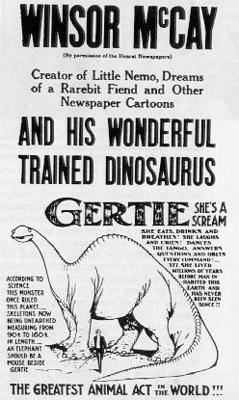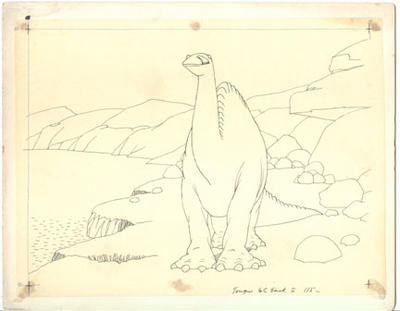(Gertie was actually McCay's third try at animation. His first two short films, featuring a boy (Little Nemo) and a mosquito, were supposedly so convincing to audiences of the time that they thought he'd somehow shot them in real life. So for his third movie, McCay decided to feature a creature he couldn't possibly have filmed live: a dinosaur.)

McCay used his Gertie movie as part of a live vaudeville act in which he interacted with the dinosaur on the screen. She did tricks on command. At one point in the performance, McCay threw food behind the screen that Gertie caught and ate on-screen. At the conclusion, McCay himself "stepped" into the screen and an animated version of the cartoonist took a ride on the beast. By all accounts, the performance was a sensation.
Until the advent of computers, virtually all animation was done on cels, transparent celluloid sheets onto which the characters were inked and painted. Artists only made multiple individual drawings for objects that moved--sometimes an entire figure, sometimes just an arm or mouth. Because cels are transparent, the animators only needed to create one background painting for each scene, on top of which they layered the cels and shot one frame of film. Then they swapped out the bits that moved and shot another frame. Repeat 100,000 times and you've got a movie.
In 1914, they hadn't figured that out yet. In Gertie, Winsor McCay and a single assistant hand-drew both character and background in every frame. Every single frame. They redrew every rock, water ripple, and blade of grass thousands of time on sheets of rice paper that, like tracing paper, were transparent enough to allow them to copy from a master drawing underneath. Then McCay glued each sheet to a piece of cardboard so they all lined up, and shot them.
There are somewhere between 200 and 300 original Gertie cels left. As I said yesterday, until a few years ago I assumed they were long destroyed. Once I discovered otherwise, I learned all I could about them and kept my eyes open. Finally, a couple of weeks ago, everything came together: a beautiful full-figure Gertie pose, good condition, a reputable dealer, and a fair price. I couldn't pass it up. I'd always resolved that I didn't deserve to have a Gertie until I could pay for it with my earnings from cartooning. Thanks to Abrams, that finally came together, too.
To read more about Winsor McCay and Gertie, see
http://www.bpib.com/illustrat/mccay.htm.
 It's old and it's important. Ten years ago, I didn't even know it (and about 300 others of its kind) still existed. The first time I saw one, I was thunderstruck. For the past five years, I've kept my eyes open, learning and looking. On my Lifetime Top Ten List, this was numbers One through Three ... and yet, I knew in my heart I didn't really deserve to have it until I was a cartoonist.
It's old and it's important. Ten years ago, I didn't even know it (and about 300 others of its kind) still existed. The first time I saw one, I was thunderstruck. For the past five years, I've kept my eyes open, learning and looking. On my Lifetime Top Ten List, this was numbers One through Three ... and yet, I knew in my heart I didn't really deserve to have it until I was a cartoonist.
 This drawing of a game pawn and die, suggested by my editor, echoes the "life is playing the odds" theme of my story. We're going to use it as a stand-alone spot illustration on one of the opening pages, and then again as part of a fine repeating pattern for the endpapers. The endpaper effect will be subtle--imagine this drawing shrunken very small and colored beige against a tan background, repeated in a diagonal pattern.
This drawing of a game pawn and die, suggested by my editor, echoes the "life is playing the odds" theme of my story. We're going to use it as a stand-alone spot illustration on one of the opening pages, and then again as part of a fine repeating pattern for the endpapers. The endpaper effect will be subtle--imagine this drawing shrunken very small and colored beige against a tan background, repeated in a diagonal pattern.  This was just a miscellaneous spot drawing I did of Mom and her dog Hero that we'll also use in the book, probably on the title page. I'm a modest guy, but I've got to say I like how Hero came out: he's attentive, doting, ready to help Mom any way he can. That pretty much captures their relationship, I think.
This was just a miscellaneous spot drawing I did of Mom and her dog Hero that we'll also use in the book, probably on the title page. I'm a modest guy, but I've got to say I like how Hero came out: he's attentive, doting, ready to help Mom any way he can. That pretty much captures their relationship, I think. This is a skectch that won't be in the book, or anywhere else. I described earlier (August 3) some of the decisionmaking that went into designing the cover. This was one idea I had, and I drew it up in about five minutes using a brush-pen that was a new tool for me. This was the first time I'd taken it out for a spin and I liked the line it produced. If I'd discovered it earlier, I might have done the whole book in brush-pen. Colored in Photoshop.
This is a skectch that won't be in the book, or anywhere else. I described earlier (August 3) some of the decisionmaking that went into designing the cover. This was one idea I had, and I drew it up in about five minutes using a brush-pen that was a new tool for me. This was the first time I'd taken it out for a spin and I liked the line it produced. If I'd discovered it earlier, I might have done the whole book in brush-pen. Colored in Photoshop.